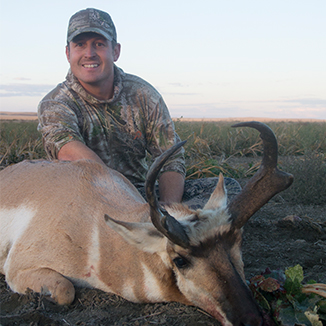
As the vast plains stretch across the eastern part of this state, so does the sky. The cold, cutting wind with traces of snow reminds us of the approaching winter. When life seems to have abandoned this barren landscape, there remains small herds of antelope grazing on the prairie. This is antelope hunting in Montana's Big Sky Country.
Every year when planning my hunting application strategy, I make sure to make room for the North American antelope. They are an amazing testament of conservation efforts as their numbers continue to grow across the West. I love hunting the antelope and feel they are often forgotten and a frequently overlooked species.
After realizing I had drawn a decent antelope permit in northcentral Montana, I gave the respect I felt this hunt deserved. I would treat this hunt like a once-in-a-lifetime hunt. The unit yields high harvest success with a few days hunted. Trophy potential is moderated, but there is always the chance of harvesting a giant. I felt that with a rigorous seven days afield, I could get that chance at a great goat.
My preparation began as it did with most hunts. First, I made a call to Huntin' Fool for information and the list of hunters who had hunted my unit in the past. Then, I called the biologist and local game wardens. Finally, I spent hours of virtual scouting on Google Earth and onXmaps. By the time the hunt approached, I felt I was ready.
Montana holds some of the largest tracts of public land unlike anywhere else in the country. In addition to public land, there are hundreds of thousands of acres of private Block Management. Staying persistent, my goal was to cover as much ground as possible. I would drive hundreds of miles of two-track roads and spend every daylight hour behind glass to locate the one.
Field judging antelope can be challenging. I first look for horn length. Long horns are pretty rare, and those that are over 14" are obvious when compared to younger bucks. Next, I look for well-formed cutters. Finally, the mass and thickness of the horns really sets mature bucks into a class of their own.
The first few days, I looked over 75-125 antelope per day. Several bucks were tempting but not quite what l was looking for. On the fourth day of the hunt, l turned up a buck that piqued my interest and warranted a closer look. He was well over a mile away and with 12 does. They were bedded in a sugar beet field with about 12 inches of green, leafy foliage. To the south of their location was a fence line. If I could get to that fence, I figured I'd have a 250-yard shot.
I quickly checked property ownership on onXmaps and was ecstatic to see the buck was on Block Management. I had to drive a few miles to gain permission to hunt. Driving back to the antelope, I parked in a hidden location and began my pursuit. My plan was to first get a closer look at about 500 yards with my spotter and then make my final decision to pursue further or retreat.
After about three-quarters of a mile of crawling and two hours later, the antelope were still laying in the midday sun. I moved slow and low. Antelope have an uncanny way of detecting danger thousands of yards away. Close to the ground, I set up my spotter for a better look. I was still over 500 yards away. The buck seemed to have all three criteria for a mature buck. He had the length, cutters, and mass. Also, his horns seemed to tip forward towards his nose. This made his horns look giant. I decided to go for the kill. I continued to crawl down the fence line. This would position me about 250 yards from the bedded buck. If you have never belly crawled, you would be surprised how long it actually takes. With the setting sun at my back and wind in my face and only short grazes to cover my approach, I continued to inch forward. Finally, I was in position, lying prone with the gun steady. Now, I had to wait for the buck to stand. It took a couple more hours before the buck stood for his final stretch. When he stood, I was ready with my finger on the trigger.
As I stood over the buck, I was overwhelmed with how well this hunt had gone. The best part of this hunt is that it can be drawn every three to four years. With thousands of acres to hunt and low application and permit costs, I see another Montana antelope hunt in my near future.